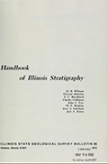Historical:Sweetland Creek Shale
Lithostratigraphy: Knobs Megagroup >>New Albany Shale Group >>Sweetland Creek Shale
Chronostratigraphy: Paleozoic Erathem >>Devonian System >>Upper Devonian Series
Allostratigraphy: Kaskaskia Sequence
Authors
Charles Collinson and Elwood Atherton
Name Origin
The Sweetland Creek Shale (Udden, 1899, p. 65-78; Collinson et al., 1967a, p. 960-961) is named for Sweetland Creek, Muscatine County, Iowa.
Type Section
The type section of the Sweetland Creek Shale is an exposure along that creek, 4 miles northeast of Muscatine (cen. N 1/2 27, 77N-1W), where it is 14 feet thick and is overlain by 6 feet of Grassy Creek Shale.
Extent and Thickness
The Sweetland Creek Shale is only a few inches thick in southwestern Illinois, but reaches 50 feet thick in northwestern Illinois and 200 feet in southeastern Illinois, where it appears to be essentially continuous with the Selmier Member of the New Albany Shale in Indiana.
Definition
As originally defined, the Sweetland Creek included all the Devonian shale at the type locality. It therefore was essentially equivalent to Grassy Creek Shale (Workman and Gillette, 1956). As now defined (Collinson et al., 1967a), the Sweetland Creek Shale is restricted to the dominantly gray and green shale that underlies the black Grassy Creek and extends throughout much of the Illinois Basin (Collinson, 1961 ; North, 1969).
Description
Although dominantly gray in the western part of Illinois, the Sweetland Creek contains some dark gray to black beds. In the central and eastern parts of Illinois, it is generally dark and not readily separated in well samples from the Blocher Shale below and the Grassy Creek Shale above. However, in that area it is easily identified on geophysical logs, which show persistent variations that permit key beds to be widely traced within the formation (North, 1969).
Fossils
Macrofossils are scarce, but the conodonts have been studied in considerable detail and indicate ages ranging from early to middle Upper Devonian (Klapper and Furnish, 1962; Collinson et al., 1962).
References
COLLINSON, CHARLES, 1961, Kinderhookian Series in the Mississippi Valley, in Northeastern Missouri and west-central Illinois: Kansas Geological Society Guidebook, 26th Annual Field Conference, Missouri Geological Survey Report of Investigations 27, p. 100-109; Illinois State Geological Survey Reprint 1961-U.
COLLINSON, CHARLES, L. E. BECKER, G. W. JAMES, J. W. KOENIG, and D. H. SWANN, 1967a, Illinois Basin, in International symposium on the Devonian System: Alberta Society of Petroleum Geologists, v. 1, p. 940-962; Illinois State Geological Survey Reprint 1968-G.
COLLINSON, CHARLES, A. J. SCOTT, and C. B. REXROAD, 1962, Six charts showing biostratigraphic zones and correlations based on conodonts from the Devonian and Mississippian rocks of the Upper Mississippi Valley: Illinois State Geological Survey Circular 328, 32 p.
KLAPPER, GILBERT, and W. M. FURNISH, 1962, Conodont zonation of the early Upper Devonian in eastern Iowa: Iowa Academy of Science Proceedings, v. 69, p. 400-410.
NORTH, W. G., 1969, Middle Devonian strata of southern Illinois: Illinois State Geological Survey Circular 441, 45 p.
UDDEN, J. A., 1899, Sweetland Creek beds: Journal of Geology, v. 7, p. 65-78.
WORKMAN, L. E., and TRACEY GILLETTE, 1956, Subsurface stratigraphy of the Kinderhook Series in Illinois: Illinois State Geological Survey Report of Investigations 189, 46 p.
ISGS Codes
| Stratigraphic Code | Geo Unit Designation |
|---|---|
